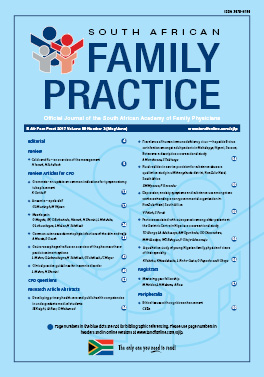Prevalence of human immunodeficiency virus — hepatitis B virus co-infection amongst adult patients in Mahalapye, Ngami, Serowe, Botswana: a descriptive cross-sectional study
Keywords:
Botswana, HBsAg screening, HIV–HBV co-infection prevalence
Abstract
Background: About 37 million people are living with human-immunodeficiency-virus (HIV) worldwide, with 2.6 million co-infected with the hepatitis B virus (HBV). HBV infection causes 650 000 deaths annually worldwide. Botswana has a high prevalence of HIV and a growing population of patients on highly active antiretroviral therapy (HAART). This study aimed to determine the prevalence of HIV–HBV co-infection amongst HAART eligible adult patients in some rural settings in Botswana. Methods: A cross-sectional study was conducted amongst HAART eligible adult patients at 15 HAART clinics in the Mahalapye, Ngami and Serowe Health Districts of Botswana, from August to October 2015. A total of 132 were recruited; of these 118 consented and were tested for HBsAg reactivity using Elisa. Results: Six (5.1%, 6/118) patients from the three rural health districts were HIV–HBV co-infected, with three in the 20–29 age group. The association between sex and HIV–HBV co-infection status was not statistically significant; p = 1.00. Conclusion: The finding of 5.1% HIV–HBV co-infection prevalence in some rural settings of Botswana was similar to results from one study conducted in a Botswana urban centre, while another previous similar study reported prevalence as being twice as high. This finding may call for prioritisation of pre-HAART HBV screening and early HAART initiation for all HIV-infected patients. (Full text of the research articles are available online at www.medpharm.tandfonline.com/ojfp) S Afr Fam Pract 2017; DOI: 10.1080/20786190.2016.1272230
Section
Research Articles
By submitting manuscripts to SAFP, authors of original articles are assigning copyright to the South African Academy of Family Physicians. Copyright of review articles are assigned to the Publisher, Medpharm Publications (Pty) Ltd, unless otherwise specified. Authors may use their own work after publication without written permission, provided they acknowledge the original source. Individuals and academic institutions may freely copy and distribute articles published in SAFP for educational and research purposes without obtaining permission.

